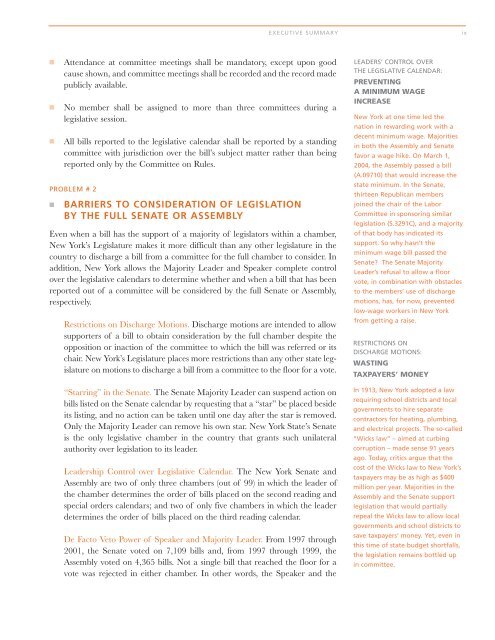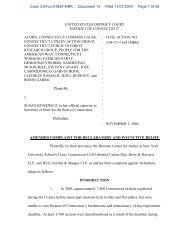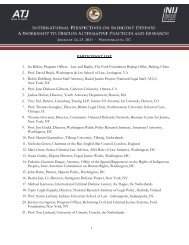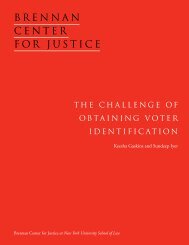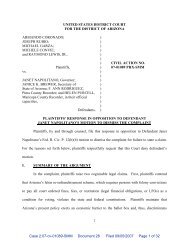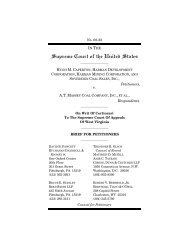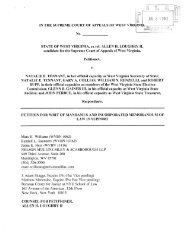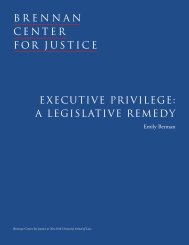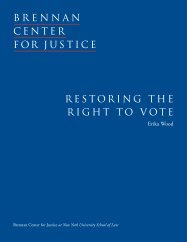THE NEW YORK STATE LEGISLATIVE PROCESS: AN ...
THE NEW YORK STATE LEGISLATIVE PROCESS: AN ...
THE NEW YORK STATE LEGISLATIVE PROCESS: AN ...
Create successful ePaper yourself
Turn your PDF publications into a flip-book with our unique Google optimized e-Paper software.
■ Attendance at committee meetings shall be mandatory, except upon good<br />
cause shown, and committee meetings shall be recorded and the record made<br />
publicly available.<br />
■ No member shall be assigned to more than three committees during a<br />
legislative session.<br />
■ All bills reported to the legislative calendar shall be reported by a standing<br />
committee with jurisdiction over the bill’s subject matter rather than being<br />
reported only by the Committee on Rules.<br />
PROBLEM # 2<br />
■ BARRIERS TO CONSIDERATION OF LEGISLATION<br />
BY <strong>THE</strong> FULL SENATE OR ASSEMBLY<br />
Even when a bill has the support of a majority of legislators within a chamber,<br />
New York’s Legislature makes it more difficult than any other legislature in the<br />
country to discharge a bill from a committee for the full chamber to consider. In<br />
addition, New York allows the Majority Leader and Speaker complete control<br />
over the legislative calendars to determine whether and when a bill that has been<br />
reported out of a committee will be considered by the full Senate or Assembly,<br />
respectively.<br />
Restrictions on Discharge Motions. Discharge motions are intended to allow<br />
supporters of a bill to obtain consideration by the full chamber despite the<br />
opposition or inaction of the committee to which the bill was referred or its<br />
chair. New York’s Legislature places more restrictions than any other state legislature<br />
on motions to discharge a bill from a committee to the floor for a vote.<br />
“Starring” in the Senate. The Senate Majority Leader can suspend action on<br />
bills listed on the Senate calendar by requesting that a “star” be placed beside<br />
its listing, and no action can be taken until one day after the star is removed.<br />
Only the Majority Leader can remove his own star. New York State’s Senate<br />
is the only legislative chamber in the country that grants such unilateral<br />
authority over legislation to its leader.<br />
Leadership Control over Legislative Calendar. The New York Senate and<br />
Assembly are two of only three chambers (out of 99) in which the leader of<br />
the chamber determines the order of bills placed on the second reading and<br />
special orders calendars; and two of only five chambers in which the leader<br />
determines the order of bills placed on the third reading calendar.<br />
De Facto Veto Power of Speaker and Majority Leader. From 1997 through<br />
2001, the Senate voted on 7,109 bills and, from 1997 through 1999, the<br />
Assembly voted on 4,365 bills. Not a single bill that reached the floor for a<br />
vote was rejected in either chamber. In other words, the Speaker and the<br />
EXECUTIVE SUMMARY ix<br />
LEADERS’ CONTROL OVER<br />
<strong>THE</strong> <strong>LEGISLATIVE</strong> CALENDAR:<br />
PREVENTING<br />
A MINIMUM WAGE<br />
INCREASE<br />
New York at one time led the<br />
nation in rewarding work with a<br />
decent minimum wage. Majorities<br />
in both the Assembly and Senate<br />
favor a wage hike. On March 1,<br />
2004, the Assembly passed a bill<br />
(A.09710) that would increase the<br />
state minimum. In the Senate,<br />
thirteen Republican members<br />
joined the chair of the Labor<br />
Committee in sponsoring similar<br />
legislation (S.3291C), and a majority<br />
of that body has indicated its<br />
support. So why hasn’t the<br />
minimum wage bill passed the<br />
Senate? The Senate Majority<br />
Leader’s refusal to allow a floor<br />
vote, in combination with obstacles<br />
to the members’ use of discharge<br />
motions, has, for now, prevented<br />
low-wage workers in New York<br />
from getting a raise.<br />
RESTRICTIONS ON<br />
DISCHARGE MOTIONS:<br />
WASTING<br />
TAXPAYERS’ MONEY<br />
In 1913, New York adopted a law<br />
requiring school districts and local<br />
governments to hire separate<br />
contractors for heating, plumbing,<br />
and electrical projects. The so-called<br />
“Wicks law” – aimed at curbing<br />
corruption – made sense 91 years<br />
ago. Today, critics argue that the<br />
cost of the Wicks law to New York’s<br />
taxpayers may be as high as $400<br />
million per year. Majorities in the<br />
Assembly and the Senate support<br />
legislation that would partially<br />
repeal the Wicks law to allow local<br />
governments and school districts to<br />
save taxpayers’ money. Yet, even in<br />
this time of state budget shortfalls,<br />
the legislation remains bottled up<br />
in committee.


